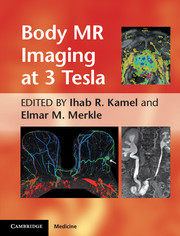Book contents
- Frontmatter
- Contents
- Contributors
- Foreword
- Preface
- Chapter 1 Body MR imaging at 3T: basic considerations about artifacts and safety
- Chapter 2 Novel acquisition techniques that are facilitated by 3T
- Chapter 3 Breast MR imaging
- Chapter 4 Cardiac MR imaging
- Chapter 5 Abdominal and pelvic MR angiography
- Chapter 6 Liver MR imaging at 3T: challenges and opportunities
- Chapter 7 MR imaging of the pancreas
- Chapter 8 MR imaging of the adrenal glands
- Chapter 9 Magnetic resonance cholangiopancreatography
- Chapter 10 MR imaging of small and large bowel
- Chapter 11 MR imaging of the rectum, 3T vs. 1.5T
- Chapter 12 Imaging of the kidneys and MR urography at 3T
- Chapter 13 MR imaging and MR-guided biopsy of the prostate at 3T
- Chapter 14 Female pelvic imaging at 3T
- Index
- Plate section
- References
Chapter 3 - Breast MR imaging
Published online by Cambridge University Press: 05 August 2011
- Frontmatter
- Contents
- Contributors
- Foreword
- Preface
- Chapter 1 Body MR imaging at 3T: basic considerations about artifacts and safety
- Chapter 2 Novel acquisition techniques that are facilitated by 3T
- Chapter 3 Breast MR imaging
- Chapter 4 Cardiac MR imaging
- Chapter 5 Abdominal and pelvic MR angiography
- Chapter 6 Liver MR imaging at 3T: challenges and opportunities
- Chapter 7 MR imaging of the pancreas
- Chapter 8 MR imaging of the adrenal glands
- Chapter 9 Magnetic resonance cholangiopancreatography
- Chapter 10 MR imaging of small and large bowel
- Chapter 11 MR imaging of the rectum, 3T vs. 1.5T
- Chapter 12 Imaging of the kidneys and MR urography at 3T
- Chapter 13 MR imaging and MR-guided biopsy of the prostate at 3T
- Chapter 14 Female pelvic imaging at 3T
- Index
- Plate section
- References
Summary
Introduction
The move to higher magnetic field strength holds promise for advancing magnetic resonance (MR) imaging of the breast. Potential benefits include higher signal-to-noise ratio (SNR), contrast, and spectral resolution, which could translate into higher spatial and temporal resolution than previously possible. However, technical, physical, and safety considerations present challenges for fully realizing these benefits for breast MR imaging.
Background on clinical utility of breast MR imaging
MR imaging has proven to be a valuable imaging tool in detecting, characterizing, and assessing the extent of breast cancer. However, due to the relatively higher costs ofMR imaging when compared to mammography and ultrasound, judicious use for specific clinically proven applications is essential. Current evidence-based clinical applications of breast MR imaging include screening high-risk patients (including patients with a known geneticmutation such as BRCA or with a greater than 20% lifetime risk based on family history), evaluating patients with a new diagnosis of breast cancer, monitoring response to neoadjuvant chemotherapy, evaluation of patients with metastatic axillary adenocarcinoma of unknown primary, and evaluation of silicone implants suspected of rupture.
- Type
- Chapter
- Information
- Body MR Imaging at 3 Tesla , pp. 26 - 33Publisher: Cambridge University PressPrint publication year: 2011
References
- 2
- Cited by



